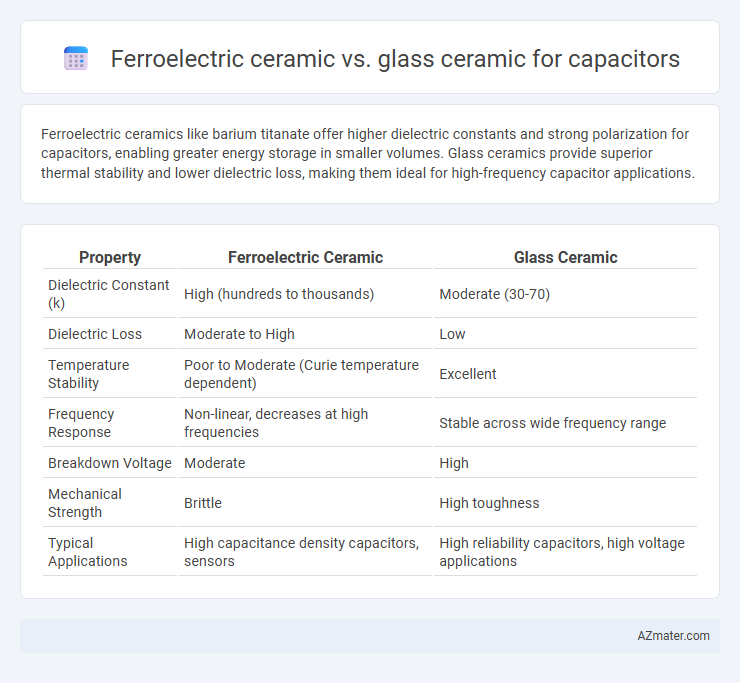Ferroelectric ceramics like barium titanate offer higher dielectric constants and strong polarization for capacitors, enabling greater energy storage in smaller volumes. Glass ceramics provide superior thermal stability and lower dielectric loss, making them ideal for high-frequency capacitor applications.
Table of Comparison
| Property | Ferroelectric Ceramic | Glass Ceramic |
|---|---|---|
| Dielectric Constant (k) | High (hundreds to thousands) | Moderate (30-70) |
| Dielectric Loss | Moderate to High | Low |
| Temperature Stability | Poor to Moderate (Curie temperature dependent) | Excellent |
| Frequency Response | Non-linear, decreases at high frequencies | Stable across wide frequency range |
| Breakdown Voltage | Moderate | High |
| Mechanical Strength | Brittle | High toughness |
| Typical Applications | High capacitance density capacitors, sensors | High reliability capacitors, high voltage applications |
Introduction to Capacitor Dielectric Materials
Ferroelectric ceramics exhibit high dielectric constants and strong polarization properties, making them ideal for capacitors requiring high capacitance in compact sizes. Glass ceramics offer superior thermal stability, low dielectric loss, and excellent chemical durability, suitable for capacitors operating in harsh environments. Selecting between ferroelectric and glass ceramic dielectrics depends on the specific application demands for capacitance, temperature tolerance, and reliability.
Overview of Ferroelectric Ceramics in Capacitors
Ferroelectric ceramics, such as barium titanate and lead zirconate titanate, exhibit high dielectric constants and strong polarization under electric fields, making them ideal for capacitor applications requiring high capacitance and miniaturization. These materials enable rapid charge-discharge cycles due to their intrinsic ferroelectric domains, which contribute to enhanced energy storage and low dielectric loss. Compared to glass ceramics, ferroelectric ceramics offer superior tunability and non-linear dielectric properties, critical for advanced capacitors in sensors, actuators, and memory devices.
Glass Ceramics: Composition and Capacitor Applications
Glass ceramics for capacitors primarily consist of silica-based glass matrices embedded with crystalline phases like lithium aluminosilicate or barium titanate, enhancing dielectric properties and thermal stability. These materials offer low dielectric loss and excellent insulation resistance, making them suitable for high-frequency and high-voltage capacitor applications. The controlled crystallization process in glass ceramics allows for tuning dielectric constants, resulting in capacitors with improved reliability and performance over ferroelectric ceramics in specific electronic components.
Dielectric Properties: Ferroelectric vs Glass Ceramic
Ferroelectric ceramics exhibit high dielectric constants typically ranging from 1000 to over 10,000, enabling greater energy storage density and tunability in capacitors. Glass ceramics feature moderate dielectric constants around 5 to 15, offering lower dielectric losses and improved temperature stability compared to ferroelectric counterparts. The nonlinear dielectric behavior and strong polarization of ferroelectric materials contrast with the linear and stable dielectric response of glass ceramics, making each suitable for different capacitor applications based on dielectric properties.
Temperature Stability and Performance
Ferroelectric ceramics exhibit high dielectric constants but often suffer from significant temperature-dependent permittivity variations, impacting capacitor stability in fluctuating temperatures. Glass ceramics provide superior temperature stability due to their inherently low dielectric loss and minimal permittivity change over a wide temperature range, enhancing performance reliability. For applications demanding consistent capacitance and low aging rates, glass ceramics outperform ferroelectric ceramics in temperature stability and overall capacitor lifespan.
Energy Density and Capacitance Comparison
Ferroelectric ceramics exhibit significantly higher energy density compared to glass ceramics, making them ideal for applications requiring compact, high-performance capacitors. The spontaneous polarization in ferroelectric materials leads to superior capacitance values, often exceeding those of glass ceramics by several folds. Glass ceramics, while offering better thermal stability and lower dielectric loss, generally have lower energy storage capability and capacitance, limiting their use in high-energy density capacitor designs.
Frequency Response Characteristics
Ferroelectric ceramics exhibit high dielectric constants and strong polarization, enabling superior capacitance at lower frequencies but suffer from nonlinear behavior and increased dielectric losses at higher frequencies. Glass ceramics offer better frequency stability and lower dielectric losses over a wide frequency range due to their amorphous structure and minimal polarization hysteresis. For high-frequency capacitor applications, glass ceramics provide more consistent frequency response and lower signal distortion compared to ferroelectric ceramics, making them preferable in RF and microwave circuits.
Reliability and Lifetime of Capacitor Materials
Ferroelectric ceramics offer high dielectric constants and excellent energy storage capabilities but may suffer from fatigue and degradation under high electric fields, impacting long-term reliability. Glass ceramics provide superior thermal stability, lower dielectric losses, and improved resistance to aging, enhancing capacitor lifetime in harsh environments. Selection between ferroelectric and glass ceramics depends on balancing the required dielectric performance with the specific reliability and durability demands of the application.
Manufacturing Processes and Cost Implications
Ferroelectric ceramics for capacitors typically require high-temperature sintering around 1200degC to 1400degC, involving complex steps like powder preparation, tape casting, lamination, and electrode integration, which increases manufacturing costs. Glass ceramics involve a controlled crystallization process of glass precursors at lower temperatures, generally around 700degC to 900degC, offering simpler production with fewer steps and reduced energy consumption, leading to lower overall costs. The higher manufacturing temperature and precision requirements of ferroelectric ceramics result in increased tooling wear and energy expenses, making glass ceramics a cost-effective alternative for large-scale capacitor production.
Application Suitability: Choosing the Right Material
Ferroelectric ceramics offer high dielectric constants and excellent tunability, making them ideal for capacitors in high-frequency and tunable RF applications where rapid response and variable capacitance are required. Glass ceramics provide superior thermal stability and low dielectric loss, making them suitable for capacitors used in harsh environments and high power applications requiring long-term reliability. Selecting between ferroelectric and glass ceramic materials depends on the specific application demands such as frequency range, temperature tolerance, and the need for dielectric constant precision.

Infographic: Ferroelectric ceramic vs Glass ceramic for Capacitor
 azmater.com
azmater.com